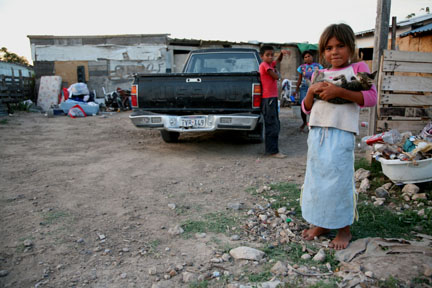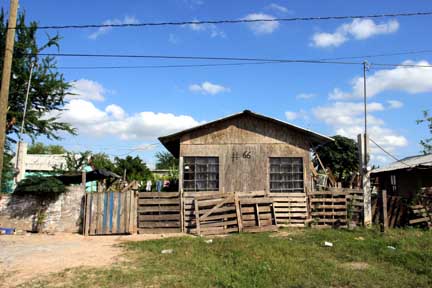
Sold by its promoters as a migration-preventing device that ultimately would produce more and better-paid jobs in all three countries, the North American Free Trade Agreement has displaced jobs and people, weakened unions and ravaged US cities and rural Mexico. But worker solidarity may prove to be its most important product.
In 1986, a provision of the Immigration Reform and Control Act created a commission to investigate the causes of Mexican migration to the United States. When it made its report to Congress in 1992, it found, unsurprisingly, that the biggest was poverty. It recommended the negotiation of a free trade agreement, modeled on the one that had been implemented a few years before between the United States and Canada. The commission argued that opening the border to the flow of goods and capital (but not people) would, in the long run, produce jobs and rising income in Mexico, even if, in the short run, it led to some job loss and displacement.
The negotiation of the North American Free Trade Agreement began within months. When completed, it was sold to the public by its promoters on both sides of the border as a migration-preventing device. During the debate, executives of companies belonging to USA-NAFTA, the agreement’s corporate lobbyist, walked the halls of Congress wearing red, white and blue neckties. They made extravagant claims that US exports to Mexico would account for 100,000 jobs in the agreement’s first year alone.
Some skeptics warned that the agreement would put downward pressure on wages and encourage attacks on unions, because its purpose was to create an environment encouraging investment and free markets. Their warnings were met with another promise – that a parallel labor side agreement would establish a mechanism for protecting workers’ rights.
Twenty years later, workers have a scorecard. The promises of profits from increased investment and freer markets were kept. But the promises of jobs and benefits for working people were not. As the commission predicted, NAFTA did lead to increasing unemployment, displacement and poverty. Workers in all three countries are still living with these devastating consequences, while the predicted long-range benefits never materialized.
US and Canadian Impact
The job loss record in the United States is not hard to document. Legislation passed by Congress when the treaty was approved contained extended unemployment benefits for workers who could show employers had moved their jobs to Mexico, and the US Department of Labor kept track of the claims. When the total passed 500,000, however, President George W. Bush ordered the Department of Labor to stop counting. The statistic was embarrassing to any politician who had supported the agreement
“By 2010, trade deficits with Mexico had eliminated 682,900 good US jobs, most (60.8 percent) in manufacturing,” according to Robert E. Scott of the Economic Policy Institute. “Jobs making cars, electronics, apparel and other goods moved to Mexico, and job losses piled up in the United States, especially in the Midwest where those products used to be made.” In a 2006 report, Scott said those deficits “displaced production that supported 1,015,291 US jobs since NAFTA took effect.”
In the past few decades, Detroit lost half its population as the auto industry left, and today every engine in a Ford comes from Mexico. Huge swaths of other industrial cities have acquired that abandoned look that comes with boarded-up homes and storefronts. But the working families who lost those outsourced jobs didn’t disappear. Instead, hundreds of thousands of people began an internal migration within the US larger than the dustbowl displacement of the 1930s. Former machinists and factory workers went on the road, got jobs in fast food restaurants or lost their families and began living on the streets.
Fear of losing a job is never far from any worker’s mind, but in some industries, fear has become terror. Employers bent on lowering wages or canceling health care plans quickly learned to use NAFTA to inspire that fear. In 1997 (three years after NAFTA went into effect), Cornell professor Kate Bronfenbrenner found that one out of every ten employers facing a union drive said they’d move to Mexico. “At ITT Automotive in Michigan,” she reported, “the company parked 13 flat-bed tractor-trailers loaded with shrink-wrapped production equipment in front of the plant for the duration of the campaign with large hot-pink signs posted on the side that read ‘Mexico Transfer Job.'” By 2009, a second report, “No Holds Barred,” found that 57 percent of employers facing a union election threatened to close their worksite.
During the NAFTA period, US wages have remained virtually flat. While factors beyond NAFTA (such as the falling rate of unionization) had an impact, NAFTA and subsequent trade agreements clearly contributed to it.
“Production workers’ wages have suffered in the United States,” Scott said. In his 2006 study, he found “there is a nationwide loss of $7.6 billion in wage premiums that would have been earned had trade been balanced.” Jeff Faux, former director of the Economic Policy Institute, adds simply, “NAFTA strengthened the ability of US employers to force workers to accept lower wages and benefits.”
AFL-CIO President Richard Trumka called NAFTA “only the first in a series of trade agreements that have undermined millions of middle-class American jobs and weakened our democratic structures. So it is ironic,” he said, “that this year the supporters of that failed model are bringing forward a fast track trade promotion bill to bring us more of the same: more trade deals that strengthen corporate power and CEO profits, while putting downward pressure on wages and opportunities for the rest of us.”
In Canada, which negotiated a free trade agreement with the United States a few years earlier, workers didn’t do much better. Despite promises that exports would rise and bring with them rising incomes, poverty increased to 12 percent in the NAFTA era, although it had been declining for the previous 20 years.
According to Bruce Campbell of the Canadian Center for Policy Alternatives, Canada’s share of US imports actually fell after NAFTA. Further, “the import content of Canadian exports increased to the point where, by 1997, more jobs were being destroyed by imports than created by exports,” he said. Canada lost 400,000 manufacturing jobs in NAFTA’s first four years then gained enough to replace them by 2001 only to again lose 198,000 jobs by 2006. Meanwhile, personal income grew by a tiny 0.6 percent per a year. And, as in the United States, unionization rates fell, from 45.5 percent in 1988 to 32.6 percent in 2003, as unionized jobs were offshored.
“Economic and political elites promised that free trade would usher in a golden era of prosperity for Canada. It clearly has not delivered the goods,” Campbell said. “It is time to reconsider whether NAFTA in its current form is contrary to the well-being of Canadian workers (and indeed of workers in all three NAFTA countries) as the overarching framework for managing North American economic relations.”
Mexican Workers Pay a High Price
 (Photo: David Bacon)Many Mexicans say that when the United States gets a cold, Mexico gets pneumonia. They mean not just that the two economies are linked, but that Mexico suffers when the US economy takes a dive. On the border, that’s not hard to see. When the current recession started in the United States, customers stopped buying the products made in the maquiladora factories just south of the US border. Hundreds of thousands of workers in those plants lost their jobs as a result.
(Photo: David Bacon)Many Mexicans say that when the United States gets a cold, Mexico gets pneumonia. They mean not just that the two economies are linked, but that Mexico suffers when the US economy takes a dive. On the border, that’s not hard to see. When the current recession started in the United States, customers stopped buying the products made in the maquiladora factories just south of the US border. Hundreds of thousands of workers in those plants lost their jobs as a result.
This is a product of NAFTA, which greatly increased the integration of the economies of the two countries. In 1994, the year the treaty went into effect, Mexico experienced a deep crisis, devalued its currency – and a million people lost their jobs. President Bill Clinton’s treasury secretary, Robert Rubin, flew to Mexico, gave its government, which had just signed the treaty, a $24 billion loan, and took control of its financial system and sequestered its oil revenue to pay for it.
Markets in Mexico were opened to large corporations, especially US ones. One casualty was Mexico’s domestic auto parts industry. The country had a domestic content law that required foreign auto assembly plants to purchase from domestic suppliers. After it was scrapped, many domestic producers no longer had guaranteed customers and closed. The producers who survived produced for export to the US, not for internal consumption. Mexico became even more an export platform, but this did not bring the promised high wages for workers.
NAFTA created an incentive for the Mexican government to hold incomes down for the vast majority of people, as a way to encourage corporate investment in the factories producing for export. This model had been pioneered in the maquiladoras on the border during the previous three decades. Under NAFTA, it became the norm throughout the country.
 (Photo: David Bacon)In a Tijuana factory assembling flat-panel televisions for export to the United States, a woman on the line has to labor for half a day to buy a gallon of milk for her children. Maquiladora workers live in homes made from pallets and other materials cast off by the factories, in barrios with no sewers, running water or electrical lines.
(Photo: David Bacon)In a Tijuana factory assembling flat-panel televisions for export to the United States, a woman on the line has to labor for half a day to buy a gallon of milk for her children. Maquiladora workers live in homes made from pallets and other materials cast off by the factories, in barrios with no sewers, running water or electrical lines.
“[Government] functionaries and businessmen tout Mexico as an ‘export powerhouse,’ but this has not diminished low wages or social inequality,” warns Arturo Ortiz Wadygmar of the Institute for Economic Investigation at Mexico’s National Autonomous University. “Instead benefits are concentrated in 500 transnational corporations and not in the pockets of Mexicans. They say Mexico has labor that is competitive in price, but this is just an elegant way of saying that it’s cheap.”
To enforce this living standard, corrupt unions politically allied to the government sign contracts, called “protection agreements,” with employers, who pay them “dues.” When workers try to organize independently, these contracts are used to prevent them from gaining the right to legally strike and bargain. If workers do organize and strike anyway, they face the combined power of the employer and the government’s system for controlling unions and workers, the Arbitration and Conciliation Boards.
In the 20 years since NAFTA was signed, Mexican labor protections, which on paper were greater than those in the United States, have been rolled back. The last administration of President Felipe Calderon forced through a set of “labor reforms” to legitimize contingent work and erode workers’ rights, and more changes are coming. Unions that have tried to stand in the way of these changes have been attacked by an alliance between the government and employers.
The head of the mineros, Napoleon Gomez Urrutia, was forced to flee to Canada when the government threatened to arrest him after he’d condemned an explosion in a mine belonging to one of Mexico’s wealthiest families as “industrial homicide.” Meanwhile, a new mining law led to the sale of mining concessions, primarily to huge Canadian companies, covering more than one-third of Mexico’s entire territory.
The 44,000 members of the Mexican Electrical Workers were fired, and the state-owned electric power company they worked for was dissolved. Now the new administration of President Enrique Peña Nieto has forced through an “energy reform” that sets up the national oil and electrical industries for sale to private investors.
As NAFTA opened the doors for a flood of private investment into Mexico, market reforms privatized other industries as well. One family became owner of its most important railroads, another of its national steel mill. Carlos Slim bought the telephone company at a bargain price and is reputedly the world’s richest man, becoming the second-largest shareholder in The New York Times. Elizabeth Malkin, The Times‘ Mexico correspondent, gushed that he’d “turned a crumbling Mexican phone monopoly into a continental telecom giant.”
 (Photo: David Bacon)According to Forbes magazine, in the past 20 years of the agreement, Mexico created at least 15 billionaires. In a diplomatic cable published by Wikileaks, the US government admits, “The net wealth of the 10 richest people in Mexico – a country where more than 40 percent of the population lives in poverty – represents roughly 10 percent of the country’s gross domestic product.”
(Photo: David Bacon)According to Forbes magazine, in the past 20 years of the agreement, Mexico created at least 15 billionaires. In a diplomatic cable published by Wikileaks, the US government admits, “The net wealth of the 10 richest people in Mexico – a country where more than 40 percent of the population lives in poverty – represents roughly 10 percent of the country’s gross domestic product.”
According to NAFTA’s supporters, especially in the Clinton administration, this systematic violation of workers’ rights would be prevented by the North American Agreement on Labor Cooperation. This promise was used to placate Democrats in Congress – who were under labor pressure to vote against NAFTA.
After 20 years, the record of the side agreement is dismal. In its last status report, the Department of Labor lists 37 cases submitted during that time – 24 against Mexico, 13 against the United States, and two against Canada. Almost all against Mexico concerned violations of the right to freedom of association, to strike and to bargain. Cases against the United States involved violations of union rights and the rights of immigrant workers. The two cases against Canada concerned violations of the right to collective bargaining.
The most any union or group of workers got from filing a case was “consultations” between the governments and public hearings. There is no process in the agreement for penalties for violation of union rights. And although there are minor penalties for violating child labor or occupational health laws, they’ve never been implemented. Not a single contract was signed as a result of the side-agreement process, nor was a single worker rehired. Those unions that have filed cases have generally sought to use the process to gain public exposure of abuses and exert indirect pressure on employers.
Agricultural Dumping Creates Migration
In the Mexican countryside, NAFTA’s impact was even sharper. Mexico imported 30,000 tons of pork in 1995. By 2010, pork imports, almost all from the United States, had grown to 811,000 tons, more than one-quarter from one company, Smithfield Foods, the world’s largest meatpacker. As a result, Mexico lost 4,000 pig farms and more than 120,000 jobs altogether.
Corn imports also rose, from 2,014,000 tons to 10,330,000 tons from 1992 to 2008. US producers like Archer Daniels Midland, subsidized by US farm bills, sold corn at artificially low prices to gain control of the Mexican market. Then small farmers in Oaxaca, Chiapas and southern Mexico couldn’t sell their crops at a price high enough to pay the cost of growing them. At the same time, retail sales in Mexico have become monopolized, and the largest retailer is now Wal-Mart.
In a 2005 study made for the Mexican government, the World Bank found that the extreme rural poverty rate of 35 percent in 1992-94, prior to NAFTA, jumped to 55 percent in 1996-98, after NAFTA took effect. This could be explained, the report said, “mainly by the 1995 economic crisis, the sluggish performance of agriculture, stagnant rural wages, and falling real agricultural prices.” By 2010, 53 million Mexicans were living in poverty, according to the Monterrey Institute of Technology – half the country’s population. About 20 percent live in extreme poverty, almost all in rural areas.
According to Fernando Ortega, the state coordinator of the Democratic Farmers’ Front of Chihuahua, “there’s nothing to celebrate about the free trade agreement. We became impoverished and dispossessed – and the government abandoned us and excluded us from development.” Ortega charges that NAFTA also produced poverty in the countryside because it forced small farmers and communal producers to compete with huge agroindustrial enterprises in Mexico, the United States and Canada that all receive huge subsidies. “By abandoning the countryside and negotiating the treaty, the government has promoted violence and the growth of organized crime in all the rural parts of Mexico.”
The growth of poverty, and now violence, in turn has fueled migration. In 1990, 4.5 million Mexican-born people lived in the United States. A decade later, that population more than doubled to 9.75 million, and in 2008 it peaked at 12.67 million. About 11 percent of all Mexicans now live in the United States. About 5.7 million were able to get some kind of visa, but another 7 million couldn’t – and came nevertheless.
That too has been a benefit for US employers, who have had access to an enormous pool of displaced people desperate for work. At the same time, US immigration policy has criminalized work for undocumented people, making it even easier for employers to demand low wages – even illegal ones. A recent survey of indigenous Mexican farm workers in California found that a third were working for less than the state’s minimum wage. At the same time, the money sent home by Mexicans working in the United States – more than $25 billion yearly – has become crucial to the survival of those left behind.
In 2009, Ken Georgetti, president of the Canadian Labour Congress, and John Sweeney, then president of the AFL-CIO, wrote to President Obama and Canadian Prime Minister Stephen Harper, reminding them that, “the failure of neoliberal policies to create decent jobs in the Mexican economy under NAFTA has meant that many displaced workers and new entrants have been forced into a desperate search to find employment elsewhere. . . . We believe that all workers, regardless of immigration status, should enjoy equal labor rights. . . . We also support an inclusive, practical and swift adjustment of status program, which we believe would have the effect of raising labor standards for all workers.”
Solidarity – NAFTA’s Most Important Product
In many cases, working people in the United States – especially if they belonged to unions, which campaigned very heavily against NAFTA – started to open their eyes to the real conditions of their compatriots or their fellow workers in Mexico. They could see this was leading to the relocation of their jobs. And in response, workers and unions, especially progressive ones on both sides of the border, have drawn together.
When the Mexican government, for instance, tried to change Mexico’s labor law or passed a corporate education reform with standardized testing or began to privatize the electrical and oil industries, US unions have cooperated with Mexican unions in fighting these changes. Many US unions today understand that the impact won’t be felt in Mexico only. It will be felt in the displacement of people and their migration to the United States and Canada.
In many cases, US, Mexican and Canadian unions are facing the same economic policies, the same trade policies – and even the same employers. Even before the treaty passed, activists in all three countries set up networks like the Coalition for Justice in the maquiladoras, the Border Committee of Women Workers and the Workers’ Support Center. The United Steel Workers became the crucial support base for miners in their four-year strike in Cananea, one of the world’s largest copper mines, and gave sanctuary to Gomez Urrutia when he was forced to leave Mexico. Some unions, like the United Electrical Workers and the Authentic Workers Front, developed a permanent strategic alliance.
This kind of cross-border cooperation and solidarity is now a fact of life in our labor movements in all three countries. It was certainly not intended by the authors of NAFTA, but it developed in spite of them, as workers learned that the effects of the agreement were felt by the working people of all three countries in very negative ways.
Maria Elena Durazo, executive secretary of the Los Angeles County Federation of Labor, emphasizes that international solidarity is not only a relationship between unions and worker organizations, but also a movement of people. She draws a connection between the displacement and dislocation caused by NAFTA, and the flow of migrants from Mexico to the United States and Canada. “We’re still paying the price for NAFTA and for the fact that we got out of the gate late in opposing it. We need strategies for dealing with its impact and building coalitions. We’ve had losses, and as unions we’ve been forced to reach out.”
For Durazo and others, building the labor movements of all three countries is the key to fighting trade agreements. And as painful as displacement is, she also points to the historic role displaced people have played, especially in the United States: “Immigrants built the US labor movement and will rebuild it, and we will fight within the AFL-CIO on this very issue.”
Copyright David Bacon. May not be reprinted without permission of the author.
Our most important fundraising appeal of the year
December is the most critical time of year for Truthout, because our nonprofit news is funded almost entirely by individual donations from readers like you. So before you navigate away, we ask that you take just a second to support Truthout with a tax-deductible donation.
This year is a little different. We are up against a far-reaching, wide-scale attack on press freedom coming from the Trump administration. 2025 was a year of frightening censorship, news industry corporate consolidation, and worsening financial conditions for progressive nonprofits across the board.
We can only resist Trump’s agenda by cultivating a strong base of support. The right-wing mediasphere is funded comfortably by billionaire owners and venture capitalist philanthropists. At Truthout, we have you.
We’ve set an ambitious target for our year-end campaign — a goal of $180,000 to keep up our fight against authoritarianism in 2026. Please take a meaningful action in this fight: make a one-time or monthly donation to Truthout before December 31. If you have the means, please dig deep.